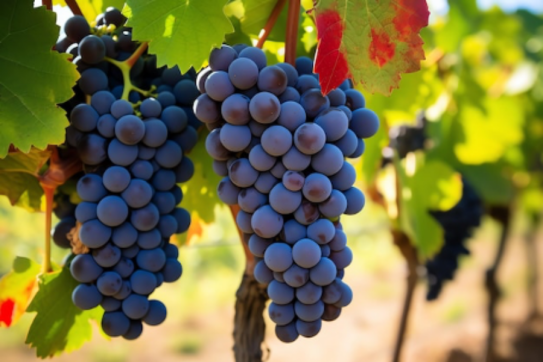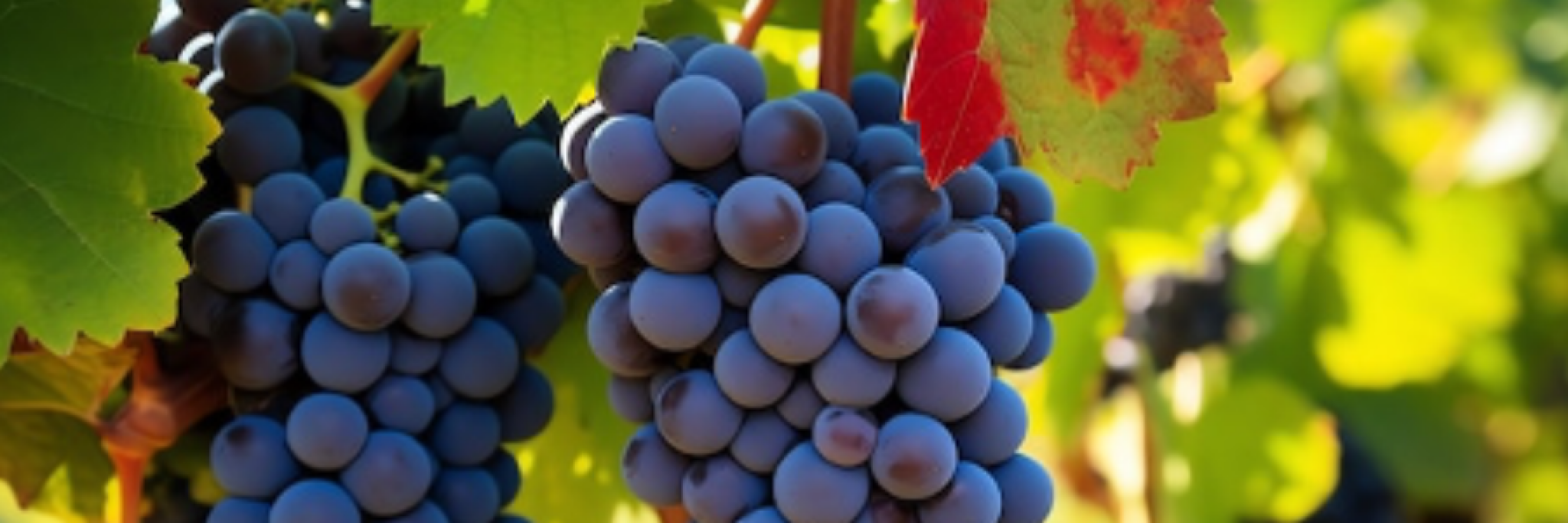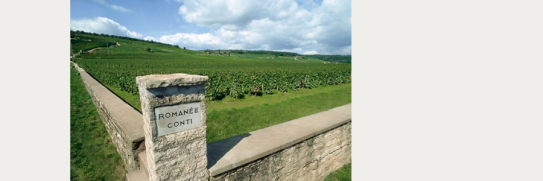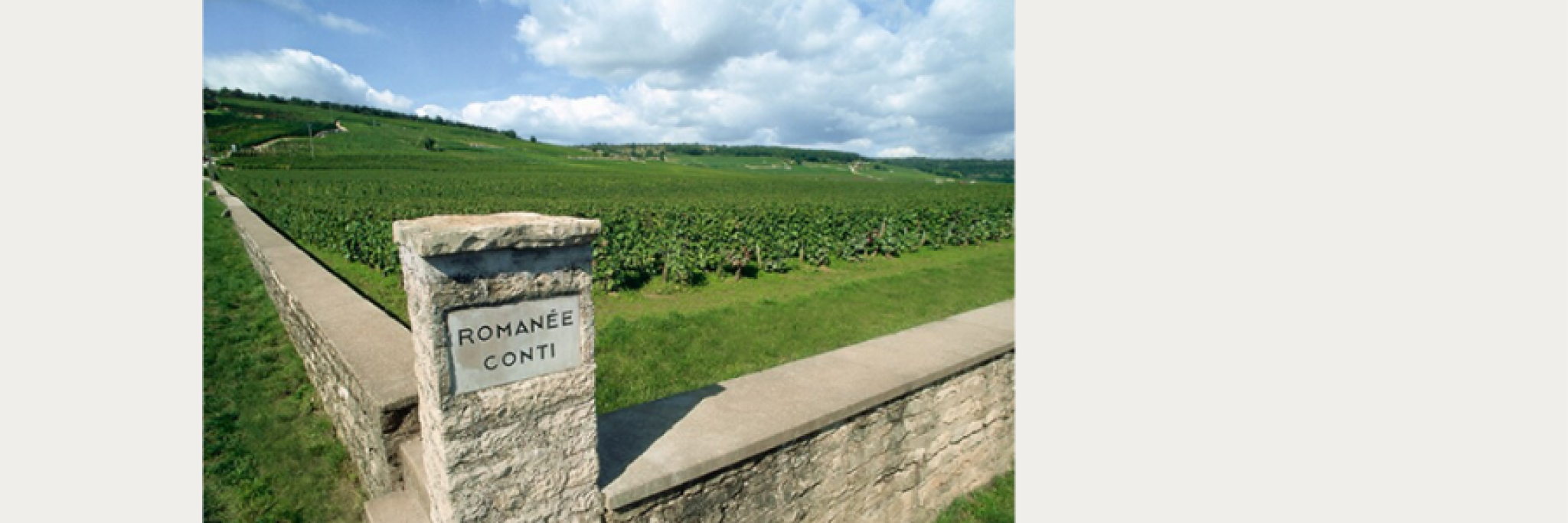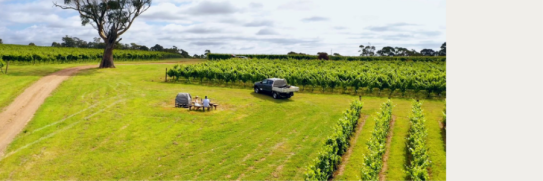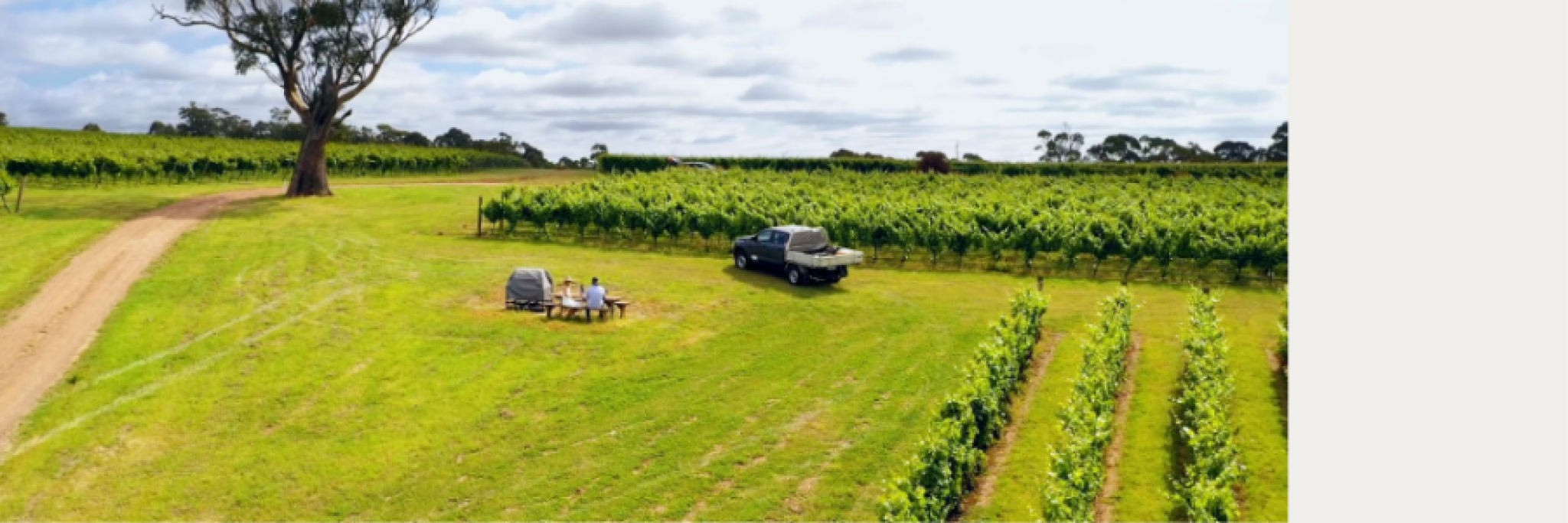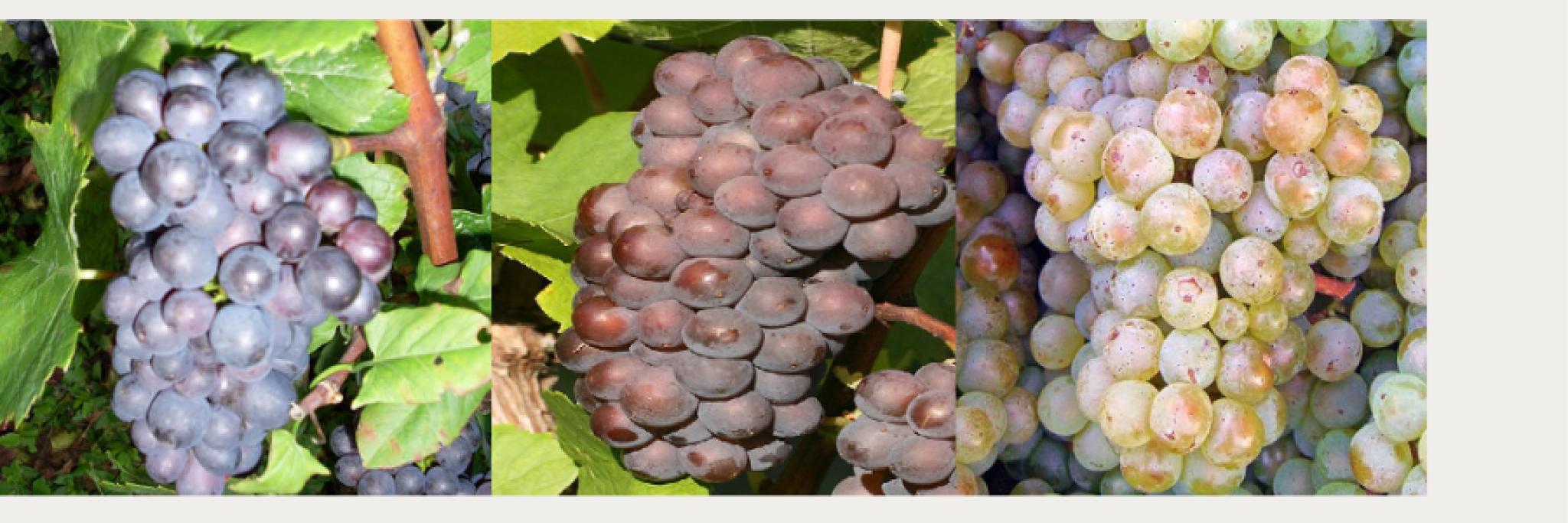The Most Prized Pinot Noir Vineyard in the World – Romanée-Conti in the Village of Vosne-Romanée, Burgundy. Not Only the Most Expensive Pinot Noir but the Most Expensive Wine (of all) in the World. The 2005 is yours for around £250,000 per 12 bottle case! (Thankfully, Peter Graham Wines have some delicious and more affordable examples – including some top Burgundies - please do look at the link)
Pinot Noir is one of the most fashionable grapes of the modern era – and rightly so – good examples at all levels are simply delicious. It is also one of the oldest varieties known. Although its precise origin is unclear what is believed to have been Pinot Noir can be traced back to Burgundy and well over a thousand years ago. It is the main grape – by law - of all red Burgundy (apart from Beaujolais where the black grape must be Gamay) and has been adopted by many other countries to make some of the world’s best red wines.
At its best it produces some of the most ethereal red wines on the planet, but it is equally highly enjoyable at a more entry level and is easy to appreciate when young too. And – “under cover” - it is a fundamental part of the blend in most Champagnes and other quality bottle fermented sparkling wines around the world. But it is by no means easy to grow and represents one of the more challenging grapes in the world if vine growers and winemakers want to enjoy its rewards – why is that so?
The legendary Californian winemaker André Tchelistcheff once said, “God made Cabernet Sauvignon, the devil made Pinot Noir”. Quite simply it is difficult and precocious to grow but the rewards are worth it for many. The challenges growers and winemakers must manage include:
- It is thin skinned which, along with tightly packed grapes in the bunch, make it an easy target for moulds and mildew in damp and humid conditions
- For a black grape it only does well in cool and moderate temperature environments – anything too hot and it develops jammy, figgy, even burnt characteristics and looses all its sensual and refined flavours and aroma
- It is highly yield sensitive – by that if you overcrop with too many bunches per vine there is rapid dilution in flavours and concentration (it’s therefore more costly to grow per hectare versus Cabernet Sauvignon and Sauvignon Blanc to take two examples)
- It mutates easily (which has created some interesting results – more later about this) but this genetic instability also means that its lifespan is relatively shorter than other varieties such as (again) Cabernet Sauvignon or Shiraz/Syrah – so replanting costs are higher pro rata
Pinot Noir’s CV - Typical Flavours and Aromas of Pinot Noir
Pinot Noir is thin skinned with relatively lower levels of both colour and tannin than many other black varieties, so structurally the wines are often a less deep red in colour and less drying in the mouth (unless a lot of new oak has been used which is rare with the variety). In fact, most Pinots have a much lighter oak touch in general so if you appreciate lighter oaked wine styles this again might be for you. This makes the wines much easier to drink and enjoy when they are younger. However, top examples still possess the concentration and power to age and evolve for many years in the bottle. The grape also has naturally high levels of acidity which makes the wines refreshing to drink but also contributes to their aging capacity. In summary, this is a grape and wine that should appeal to people looking for plenty of flavour and aroma but not too full bodied nor too dry in texture – I am sure this is one of the reasons it has become so popular.
Regarding flavours and aroma there is a distinct difference between young and mature Pinot Noir. When young the predominant fruit flavour is red – both soft and berry fruits, and cherry. The vanilla and toast oak touch are usually light and delicate and there is often a soft spice note of either clove or cinnamon which can be very attractive.
When mature you still find that red fruit core but now an overlay of what it often described as “forest floor” (wet leaves) along with notes of mushroom. This can take up to 10 years in top examples to evolve and become stronger of course with further bottle aging.
Burgundy – Pinot Noir’s Spiritual Home
Burgundy – and especially the sub region of the Côte de Nuits in the Côte d’Or – has adopted and adapted Pinot Noir for many centuries; and have refined both the vineyard locations and winemaking techniques to elevate it to levels which other aspire to replicate – top examples are simply the standard bearer – but sadly many famous village and single vineyard names are these days at eye watering prices. This is as much driven by the paucity of production as the imagery and aspiration to drink these wines. That is why a good wine supplier looks to offer other exciting and more affordable example from around the world, as well affordable examples from Burgundy itself. In addition, and very importantly, the quality and reputation of the producer is as important as the region of origin.
Pinot Noir is an early budder and ripener and has adapted well to the limestone clay soils and continental climate of Burgundy so much so that the best and most elevated sites have been formally classified into either Premier or the superior Grand Cru appellations. These are not only the finest expression of the grape, but their sizes are in general tiny, so the element of rarity has heightened their reputations and of course price along the way. About 97% of the Côte de Nuits is planted with Pinot Noir and this enclave extends into the Côte de Beaune to include Corton, Beaune, Pommard, and Volnay which are also predominantly or exclusively devoted to Pinot Noir. In general, the Burgundy classification hierarchy is as follows (for white as well as red):
- Village (eg Gevrey-Chambetin)
- Premier Cru single vineyard (within the village)
- Grand Cru single vineyard (within the village)
- Bourgogne Rouge is a generic entry level blend of multiple sites which still can be very good
I have gone for a superb red Burgundy example from PGW and from a very good producer – Domaine Jean-Jacques Girard and their Premier Cru Savigny-lès-Beaune vineyard Les Serpentièrs - and the brilliant 2018 vintage. Now 7 years old there is bold, bright, red fruit character but also the hint of first floor emerging – this is a forceful but elegant example of classic red Burgundy.
In the rest of France Pinot Noir is an important varietal and grown successfully in the following areas:
- Alsace – it makes the only red in a white wine production region
- Loire Valley – especially in eastern enclaves for both rosé and lighter bodied reds – most famously in Sancerre
- Jura – especially important for bottle fermented sparkling wine
Top Pinot Noirs from around the World
Given the demands of Pinot Noir for sensitive growing conditions options to plant elsewhere in the world are more limited (versus say Cabernet Sauvignon which is much more tolerant). Winemaking techniques which bring the best out of Pinot Noir are relatively easy to replicate so the focus has been in the New World (and to a lesser degree elsewhere in Europe) to find these ideal conditions – both soils and above all cool to moderate climate. The result is that plantings of Pinot Noir are – no surprise – much less than say other international black varieties such as Cabernet Sauvignon, Merlot, and Shiraz (Syrah). But where they have been thoughtfully planted and nurtured the results have been spectacular and today top sites and producers are making the finest Pinot Noirs ever outside of Burgundy and challenging that iconic heartland as never before.
Those counties and regions which are succeeding especially well include:
- Germany
- With its natural cool climate growing conditions are automatically in line with Burgundy and in several QBA regions this grape – called Spätburgunder in the country – both production levels and quality have risen dramatically. The leading regions is Baden. But the Pfalz and Rheinhessen are also increasing plantings, and it is appearing too in the Mosel
- And Austria, too, is extending its plantings of Pinot Noir with increasing acclaim
- With its natural cool climate growing conditions are automatically in line with Burgundy and in several QBA regions this grape – called Spätburgunder in the country – both production levels and quality have risen dramatically. The leading regions is Baden. But the Pfalz and Rheinhessen are also increasing plantings, and it is appearing too in the Mosel
Here is an example of this more delicate Germen red berry style from Oliver Zeter Pfalz Pinot Noir
https://petergrahamwines.com/p/pinot-noir-oliver-zeter
- New Zealand
- New Zealand has the most moderate (mainly maritime) climate of all New World countries and has focused on Pinot Noir as its lead black grape for many years now with a couple of regions in particular – South Island Central Otago and North Island Martinborough where it is the predominant variety by any colour. Top wines from here can challenge the best of Burgundy head on. in addition, Marlborough – despite its ongoing skew and focus for Sauvignon Blanc – has increased plantings and is making increasingly stylish wines. New Zealand Pinots arguably offer the best quality to price ratio too
Try this classic Central Otago example to see what all the fuss is about The Picnic Two Paddocks with its savoury ripe red fruit character
https://petergrahamwines.com/p/19-pinot-noir-picnic-two-paddocks
- South Africa
- In general, most areas are too hot but one has the ideal conditions and focused on the variety for many years now and to great success – Hemmel-en-Aarde in Walker Bay. Today Pinot Noir has become the main black grape focus for the region and there are several top producers making increasingly fine Burgundian styled examples
- South Africa also crossed Pinot Noir with Cinsau(l)t in 1925/6 to create its home-grown variety Pinotage
- In general, most areas are too hot but one has the ideal conditions and focused on the variety for many years now and to great success – Hemmel-en-Aarde in Walker Bay. Today Pinot Noir has become the main black grape focus for the region and there are several top producers making increasingly fine Burgundian styled examples
- USA
- There are two main states which are on the top of their game – California (no surprise) in key cool climate areas such as Carneros, Russian River (Sonoma), Monterey, and Santa Barbara. The other state is Oregon and especially wines firm The Willamette Valley (NB there are 2 new PGW Pinots about to land on the system from Oregon – Sokol Blosser Evolution and Kelley Fox Mirabai
- Canada also has the climate and potential to produce fine examples which are just starting to appear on the market
- There are two main states which are on the top of their game – California (no surprise) in key cool climate areas such as Carneros, Russian River (Sonoma), Monterey, and Santa Barbara. The other state is Oregon and especially wines firm The Willamette Valley (NB there are 2 new PGW Pinots about to land on the system from Oregon – Sokol Blosser Evolution and Kelley Fox Mirabai
In Australia the climate is generally too hot but there are pockets of increasingly fine, and in some cases outstanding Pinot Noir being made. These include Tasmania, Geelong, Yarra Valley, and Mornington Peninsular in Victoria.
A very good and refined example of the new face of Ozzie Pinot Noir is the elegantly fruity, smooth, and highly quaffable Dalrymple Piper’s River Block from Tasmania
Dalrymple Vineyards, Tasmania – Good Place for a Picnic
South America is probably the least developed yet for the variety especially with Argentina’s climate and focus on Malbec. But Chile does have potential in cooler spots north of Santiago such as Casablanca, St Antonio, and Leyda Valley, along with Limari Valley even further to the north.
And watch this space for England – we know how successful English sparkling wine producers are with using Pinot Noir in their blends – there are signs that the English still wine scene is getting better when focusing on Pinot Noir as the main red option. PGW are expanding their offering here too with local Norfolk examples from Flint Vineyards and Burn Valley.
Pinot Noir Does Rosé
With its lighter skin colour pigments and intense fruity nature Pinot makes excellent rosé wine when handled sensitively. It comes into its own when used in blends to make Rosé Champagne but also for still wines. Classically this includes Sancerre Rosé in The Loire valley where – by law – they must make this wine (and the red version) from Pinot Noir. But many New World producers – especially in New Zealand are seeing the potential too for the variety in this style.
Try out this excellent and very fruity and refreshing, off-dry example from Allan Scott and the Marlborough region
https://petergrahamwines.com/p/rose-estate-allan-scott
Champagne and Bottle Fermented Sparkling Wines
Pinot Noir has been used for centuries as part of the blend in Champagne (along with Chardonnay and (Pinot) Meunier) so other quality oriented bottle fermented sparkling wine producers have naturally followed that recipe too. The grape adds texture/body and soft red berry fruit qualities to these wines – and can be used on its own to make a “Blanc de Noirs” Champagne style. And as mentioned can be used to provide colour for Rosé Champagne. The grape is therefore an important component in all quality bottle fermented sparkling wines from around the world – and this has even extended into the production of Cava in Spain where is can legally be used in blends. And, of course, it is a key component in Burgundy’s sparkler Crémant de Bourgogne.
So, with summer in mind, lets finish this selection with a classic Rosé Champagne from the high quality independently owned house of Henriot with over 50% of the blend made up of Pinot Noir and 35% with older Réserve wines – dry, bright berry fruits and plenty of toasty notes
https://petergrahamwines.com/p/rose-henriot-nv-champagne
Twist in the Tale
Left to Right – Pinot Noir, Pinot Gris, Pinot Blanc
As mentioned earlier Pinot Noir mutates relatively easily and over the course of centuries this has resulted in several “sister” varieties – most famously Pinot Blanc and Pinot Gris (aka Grigio in Italy). And with Pinot Gris/Grigio (meaning grey in Franch and Italian) you clearly see the genetic residue of a black grape origin in the colour of the skins when the grapes ripen – hence why you can make a light rosé style with skin contact during fermentation. There is also some evidence that Pinot Meunier (as used in many Champagne blends) is a further example of a mutation.
Pinot Noir and Food
The variety is highly flexible with many foods and dishes but highlights to pair with for me include:
- Lamb
- Duck and other lighter Game
- Chicken and Pork
- Charcuterie
- Mushrooms in general and especially mushroom risotto
- Most Pizzas! (meat and veggie)
- Red Pepper Hummus and Pita bread (I have been told)
- And yes – richer, oily fish such as Salmon and Sea Trout (especially Rosé Pinot Noir)
And finally, in summer months you can enjoy Pinot Noirs served cool – by that 20-30 minutes in the fridge it really lifts the fruitiness in the wine whilst the temperature is pleasurable on a hot day.

